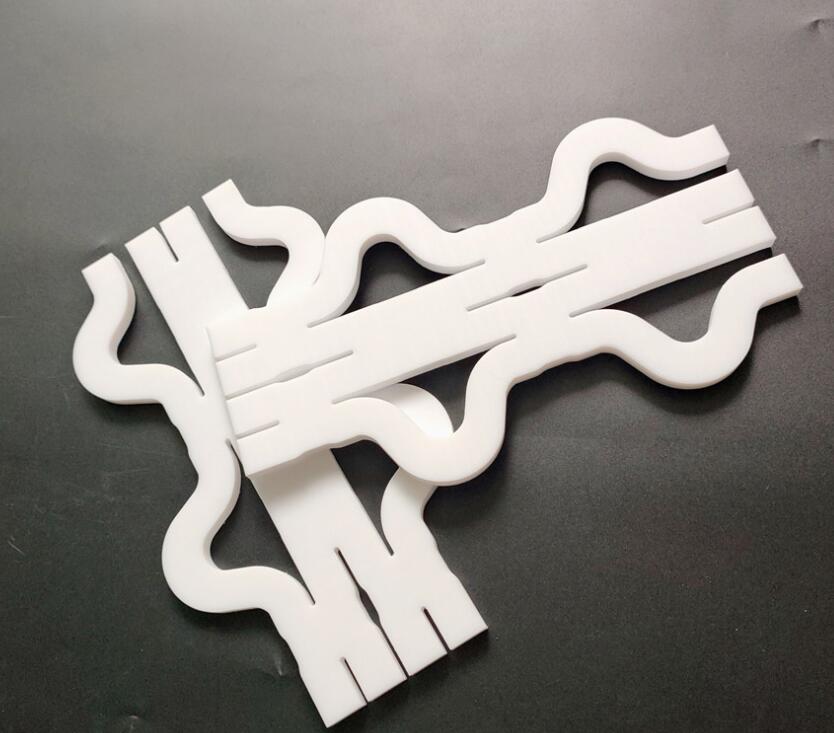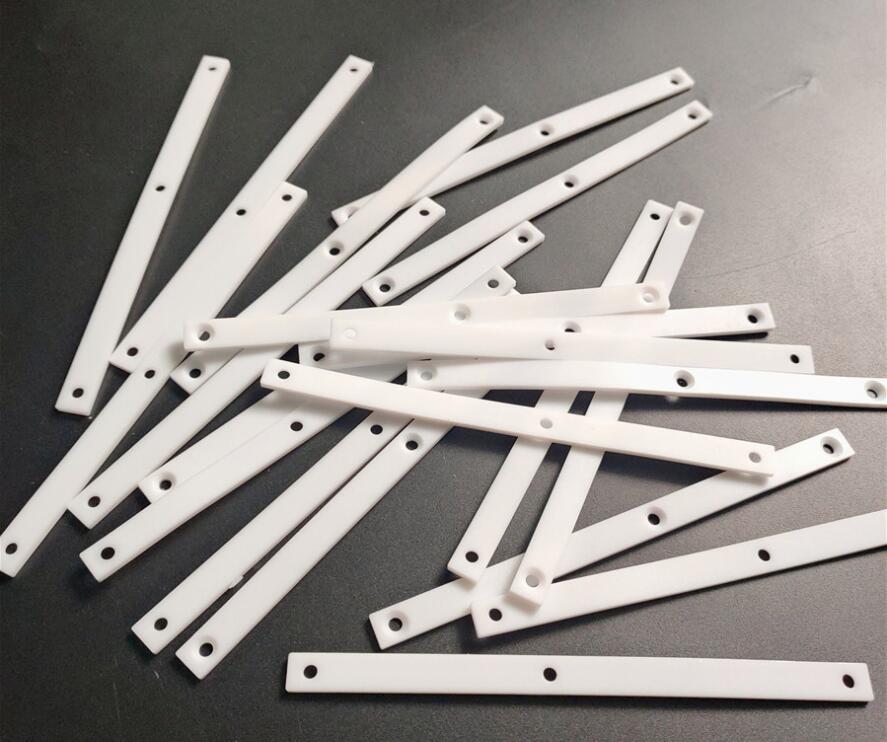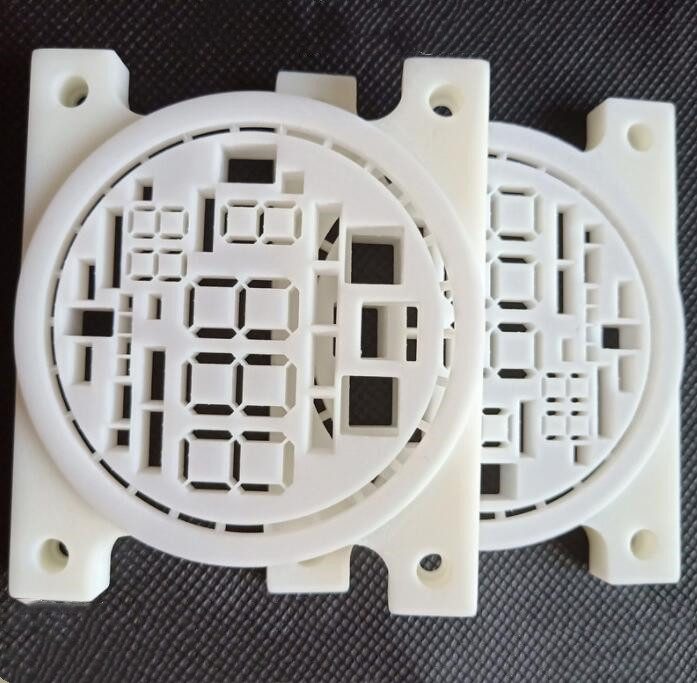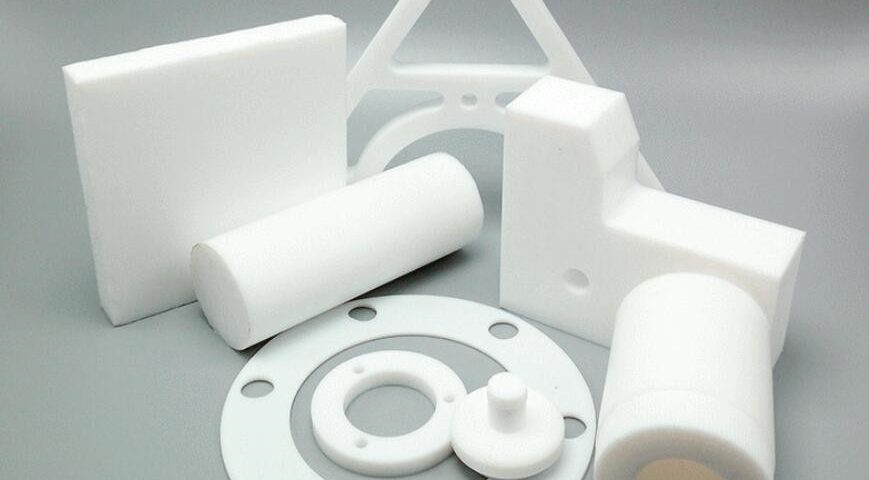- What is Teflon/PTFE Material?
- What Makes Teflon/PTFE Unique in CNC Machining?
- What are the Different Machining Processes for Teflon/PTFE?
- What are the Considerations and Tips for Machining Teflon?
- Why is CNC Machining More Suitable for Teflon/PTFE Material?
- What are the Applications of Teflon/PTFE Machining?
- What are the Disadvantages of Teflon/PTFE Machining?
- What Are Alternative Materials to Teflon/PTFE?
- Conclusion
What are the considerations and tips of Machining Teflon/PTFE
In CNC machining, where precision and expertise reign supreme, one material often poses a unique challenge: Teflon, also known as PTFE. I’ve navigated these challenges firsthand, transforming them into opportunities for innovation and precision.
In this post, I’ll dive into the nuances of machining Teflon/PTFE, sharing key considerations and practical tips from my extensive experience. Whether you’re a seasoned machinist or new to the field, understanding how to work with Teflon effectively can significantly enhance the quality and efficiency of your projects.
Keep reading as I unravel the secrets behind successfully machining one of the industry’s most intriguing materials. Let’s unlock the potential together!

What is Teflon/PTFE Material?
Teflon, more formally known as Polytetrafluoroethylene (PTFE), is a synthetic fluoropolymer of tetrafluoroethylene. I’ve seen this material evolve into an industry favorite in many years at the helm of a CNC machining service. Why, you ask? It’s simple: Teflon’s exceptional properties make it highly versatile and desirable.
Firstly, Teflon is renowned for its high resistance to heat, being stable in temperatures up to 260°C (500°F). This makes it an ideal candidate for applications requiring durability in extreme conditions. Moreover, its low coefficient of friction means it’s slicker than a politician in election season – nothing sticks to it, and it offers excellent lubricity.
Teflon’s chemical inertness is another feather in its cap. It laughs in the face of acids, bases, and solvents, making it perfect for corrosive environments. Its high electrical insulation properties make it a mainstay in the electrical and electronics industries.
But let’s not forget, Teflon isn’t just tough; it’s also lightweight. This combination of durability and lightness makes it a go-to choice for various applications, from aerospace to household cookware.
What Makes Teflon/PTFE Unique in CNC Machining?

Firstly, Teflon’s non-stick property is a double-edged sword. While it’s fantastic for end-use applications, it’s a trickster during machining. The material tends to “smear” or deform under the tool, making precision machining a bit of a tango.
Then there’s the issue of heat. Teflon doesn’t conduct heat well, which means it can get a bit hot under the collar or the cutting tool, to be precise. This poor thermal conductivity requires careful management of cutting speeds and feeds to avoid overheating and material deformation.
Teflon’s softness and flexibility also set it apart. Compared to metals or more rigid plastics, machining Teflon is like sculpting butter – it requires a gentle touch and an understanding of how the material flows. We often use sharper tools and specific cutting angles to ensure clean cuts and minimal material distortion.
Another unique aspect is Teflon’s reaction to stress. It has a high creep rate, meaning it can gradually deform under long-term pressure. This property demands precise calculations and allowances in design and machining to ensure the final part holds its shape over time.
And let’s remember Teflon’s chemical inertness and high resistance to wear and tear make it a darling in chemically aggressive environments. This quality demands special attention during machining to maintain these properties, especially in sealing surfaces or areas prone to high wear.
What are the Different Machining Processes for Teflon/PTFE?
CNC Milling: This is a cornerstone in our arsenal for machining Teflon. CNC milling allows for intricate designs and precise tolerances. However, milling Teflon is like conducting a delicate symphony requiring the right tools, speeds, and feeds.
We often use single-point cutting tools made from high-speed steel or carbide with sharp edges to minimize friction and heat. The key is maintaining a balance between speed and accuracy, preventing material deformation while achieving the desired shape and finish.
CNC Turning: Teflon’s softness and tendency to deform under pressure make turning challenging yet rewarding. We utilize CNC turning for creating cylindrical or round components.
The art here lies in selecting the right cutting tools and parameters. Using a combination of slow speeds, fast feeds, and sharp, positive-rake angle tools, we mitigate material smearing and achieve a smooth surface finish.
Drilling and Tapping: Drilling Teflon requires a patient and steady hand. Due to its soft nature, the material can quickly grab onto the drill bit, leading to oversized holes or rough finishes. We often use parabolic flute drills with a high helix angle, ensuring smoother chip evacuation and reduced heat generation.
Tapping threads in Teflon is an art in itself. Given Teflon’s low strength and high creep, we carefully design and execute taps to ensure threads are precise yet robust enough to withstand application demands.
Grinding and Finishing: Precision grinding of Teflon is crucial for achieving tight tolerances and smooth surface finishes. We use diamond grinding wheels to achieve a high-quality finish. The low thermal conductivity of Teflon means heat dissipation is poor during grinding, so a gentle approach with frequent cooling intervals is essential.
Die Cutting and Waterjet Cutting: For thinner sheets of Teflon, die cutting offers a quick and efficient method to create precise shapes. On the other hand, waterjet cutting is a non-traditional method we employ for thicker Teflon plates.
It uses a high-pressure stream of water, sometimes mixed with abrasives, to cut the material. This process is excellent for avoiding heat buildup and maintaining material integrity.
What are the Considerations and Tips for Machining Teflon?

Machining Teflon/PTFE is not just about removing material; it’s about understanding and respecting its unique properties. Over the years at Worthy Hardware, we’ve gathered much experience in this area. Here are some key considerations and tips:
Tool Selection
The choice of cutting tool is paramount. Sharp, high-speed steel or carbide tools are ideal. The stronger the tool, the cleaner the cut, and the less heat generated, which is crucial given Teflon’s low thermal conductivity.
Control Heat Buildup
Managing heat is a significant challenge when machining Teflon. Excessive heat can cause the material to deform or even melt. We often use coolants or reduce cutting speeds to mitigate this. Additionally, sharp tools and the correct cutting angles help minimize friction, reducing heat generation.
Support the Material
Due to its soft nature, Teflon can easily deform under machining forces. Proper support and fixturing are critical. We use custom fixtures to securely hold the material, distributing the machining forces evenly to prevent deformation.
Minimize Material Smearing
One of the quirks of Teflon is its tendency to smear during machining. To combat this, we use a combination of correct feed rates, sharp cutting tools, and, occasionally, freezing the material to increase its hardness temporarily.
Adjust for Creep
Teflon has a high creep rate, which can deform under long-term loads. This characteristic requires careful consideration during design to ensure dimensional stability over the product’s lifetime.
Finishing Techniques
Achieving a high-quality surface finish on Teflon can be challenging. We often use fine-grit sanding and polishing techniques post-machining to obtain a smooth surface. For critical applications, a final chemical etching can be employed to remove any residual stresses and smears.
Environmental Considerations
Teflon machining can produce fine dust and particles that must be managed carefully. Adequate ventilation and dust extraction systems are essential to maintain a safe working environment.
Managing Tolerances
Teflon’s properties require a nuanced approach to maintaining tight tolerances. Due to its tendency to deform and creep, we often apply conservative tolerance ranges compared to more rigid materials.
Deburring Techniques
Given Teflon’s soft nature, traditional deburring methods can sometimes cause more harm than good. We employ a combination of manual deburring with specialized tools and chemical deburring processes to gently remove any burrs without damaging the part. This ensures a clean and smooth finish, which is crucial for components used in sensitive applications.
Accounting for Softness
The softness of Teflon presents unique challenges, especially in maintaining structural integrity during machining. We use lower cutting forces and ensure optimal support for the material to prevent it from moving or distorting. Careful planning of the machining process, including the order of operations, is crucial to maintain the part’s integrity.
Preventing Deformation
Teflon’s susceptibility to heat and pressure-induced deformation demands a strategic approach. We often use coolants and choose machining techniques that distribute the stress evenly across the part. For parts that require high precision, we might machine them slightly oversized and allow them to settle or “relax” before performing final finishing operations.
Surface Finishing and Inspection
Post-machining, surface finishing, and inspection are crucial, especially given Teflon’s propensity for smearing and deformation. We conduct thorough inspections using precision measuring tools to ensure the final product meets the desired specifications.
Why is CNC Machining More Suitable for Teflon/PTFE Material?
Precision and Complexity:
CNC machining excels in precision, which is paramount when working with Teflon/PTFE. The material’s softness and susceptibility to deformation demand a machining process that can achieve tight tolerances and intricate designs.
CNC machining provides:
- This precision.
- Allowing us to produce complex parts with exacting standards.
- Something that manual machining methods struggle to match.
Consistency and Reproducibility:
Teflon parts often require consistency, especially in high-volume production. CNC machining offers unparalleled repeatability. Once the parameters are set, CNC machines can produce piece after amount with minimal variance, ensuring each component meets the same high-quality standards.
This consistency is crucial, especially for aerospace, medical, and automotive industries, where even minor deviations can have significant implications.
Reduced Material Waste:
Teflon isn’t just unique; it’s also not the most economical material. CNC machining allows for efficient material utilization, minimizing waste. The ability to precisely control the cutting tools means we can maximize the use of material, producing more parts per sheet or rod.
This efficiency is cost-effective and aligns with our commitment to sustainable manufacturing practices.
Flexibility in Machining Operations:
CNC machining offers a level of flexibility that is unmatched by other methods. CNC machines can handle a wide range of operations, whether milling, turning, drilling, or even complex 3D machining.
This versatility is particularly beneficial for Teflon/PTFE, as it allows us to adapt the machining process to each project’s specific requirements, whether a simple bushing or a complex, high-precision part.
Controlled Machining Environment:
The controlled environment of CNC machining is another advantage. Teflon/PTFE’s sensitivity to heat and pressure requires a machining process where environmental factors like temperature and humidity are well-regulated.
CNC machines operate in controlled conditions, ensuring that external factors do not adversely affect the machining process or the material properties.
What are the Applications of Teflon/PTFE Machining?

Teflon’s high-temperature resistance and low friction make it ideal for components like seals, gaskets, and bearings in the aerospace sector. These parts benefit from Teflon’s ability to perform under extreme conditions, ensuring reliability and safety in the skies.
The biocompatibility of Teflon makes it a star in the medical field. We machine Teflon for surgical instruments, implantable devices, and insulation for electrical medical equipment. Its chemical inertness ensures it does not react with the human body, making it safe for medical applications.
Teflon’s excellent electrical insulation makes it a preferred material in electronics. We produce insulators, connectors, and other components that benefit from Teflon’s ability to withstand electrical environments without degrading.
In chemical processing, Teflon’s resistance to corrosive substances is invaluable. We manufacture valves, pumps, and piping components that can resist the harsh chemicals used in this industry, ensuring longevity and safety.
The automotive industry benefits from Teflon’s durability and heat resistance. From high-performance seals to insulators in electrical systems, Teflon parts machined by us ensure reliability and performance under the hood.
Teflon’s non-reactive nature makes it safe for food contact. We machine components for food processing equipment that require non-stick properties and resistance to cleaning chemicals.
The semiconductor industry requires materials that can withstand extreme environments. Teflon parts machined for this sector include wafer carriers and insulation components, capitalizing on Teflon’s thermal stability and chemical resistance.
What are the Disadvantages of Teflon/PTFE Machining?
Sensitivity to High Temperatures: Despite its excellent heat resistance, Teflon starts to degrade at temperatures above 260°C (500°F). This limits its use in ultra-high-temperature applications. In machining, this means carefully managing heat generated by cutting tools to avoid damaging the material.
Creep Under Load: Teflon, known as creep, tends to deform under continuous load. This can be a drawback in applications requiring dimensional stability over time. In machining, we compensate for this by adjusting designs and tolerances, but it remains a factor to consider, especially in load-bearing applications.
Lower Mechanical Strength: Compared to metals and other engineering plastics, Teflon’s mechanical strength is on the downside. This can limit its use in applications where high strength and rigidity are crucial. We often have to balance the design to leverage Teflon’s strengths while compensating for its lower mechanical properties.
Difficulty in Bonding: while beneficial in many applications, Teflon’s non-stick nature makes it challenging to bond or glue. Unique surface treatments and adhesives are required for adequate Bonding, adding complexity to the manufacturing process.
Cost: Teflon is generally more expensive than many conventional plastics. The material cost and the specialized machining requirements can make Teflon parts more costly. This can be a significant factor in budget-sensitive projects.
Environmental Concerns: The production of Teflon involves chemicals that raise ecological and health concerns. While the final product is inert and safe, manufacturers and users need to be mindful of the environmental impact of Teflon production.
Machining Complexity: Teflon’s softness and tendency to deform require specialized machining techniques. This can extend machining time and require skilled operators, impacting production efficiency and cost.
What Are Alternative Materials to Teflon/PTFE?
PEEK (Polyether Ether Ketone): If Teflon is the king of chemical resistance, PEEK is the queen of mechanical strength. It’s an excellent alternative for higher mechanical strength and thermal stability applications. PEEK retains its properties at temperatures up to 250°C (482°F) and offers superior wear and abrasion resistance.
Nylon: Nylon is a more cost-effective alternative with good wear resistance and mechanical strength. Teflon is more heat resistant than Teflon but is suitable for many applications, especially where cost is a significant consideration.
Polypropylene: For applications that require chemical resistance but not the high-temperature tolerance of Teflon, polypropylene is a solid choice. It’s also more rigid than Teflon, making it suitable for specific structural applications.
PVDF (Polyvinylidene Fluoride): PVDF is another fluoropolymer with properties similar to Teflon. It offers good chemical resistance and can handle higher temperatures than polypropylene and nylon, though less relatively as high as Teflon.
UHMW (Ultra High Molecular Weight Polyethylene): UHMW is known for its high impact strength and abrasion resistance. It’s a good alternative in applications where durability and wear resistance are more critical than high-temperature performance.
PCTFE (Polychlorotrifluoroethylene): Like Teflon’s chemical resistance, PCTFE offers better dimensional stability and lower creep under load. This makes it suitable for applications where maintaining precise tolerances over time is critical.
Conclusion
Are you seeking precision CNC machining solutions for Teflon/PTFE or alternatives? Do you have a project that demands the unique properties of these materials? Look no further. At Worthy Hardware, we’re not just experts in machining; we’re partners in your manufacturing journey, committed to delivering quality, precision, and value.
Reach out to us to discuss your project requirements. Our team is ready to give you the expertise and support to make your ideas a reality. Let’s create something exceptional together!

